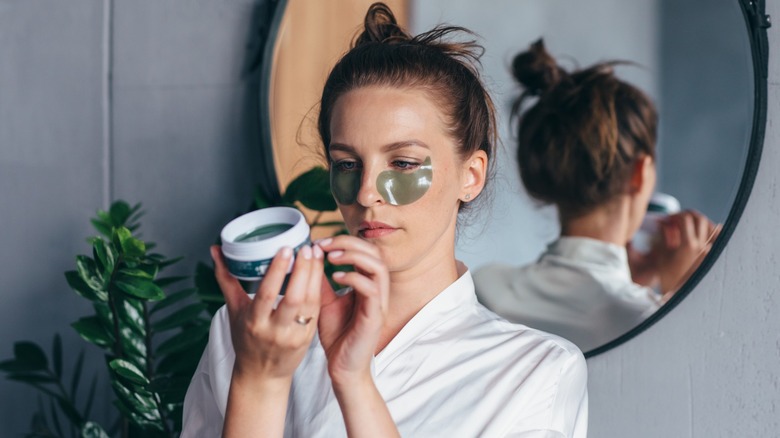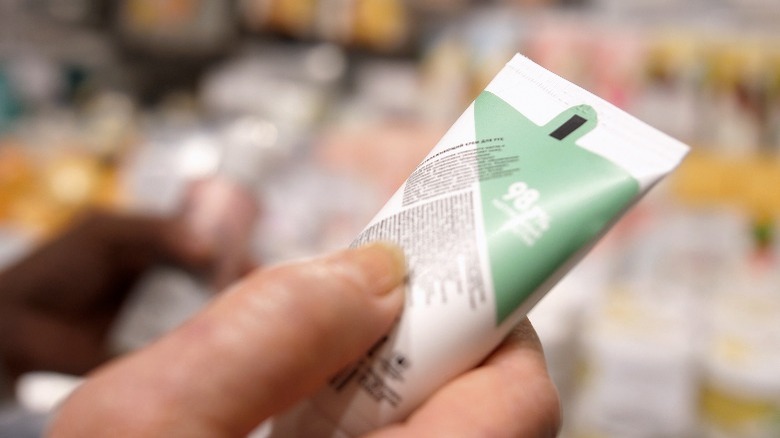Why The Noncomedogenic Label On Your Skincare Products Isn't As Important As You Think
We may receive a commission on purchases made from links.
"Comedogenic" and "noncomedogenic" are two common terms used to express the nature of certain skincare products. A quick translation: comedogenic means an ingredient will clog pores, and a noncomedogenic one will not. Or so we thought.
What if we told you the products that have been labeled noncomedogenic actually entail some risk of clogging your pores? Would you want to know? Labels for cosmetics are well-known to be unreliable, considering the fact that cosmetics do not go through approval from the Food and Drug Administration (FDA). As such, skincare brands do not need to prove their products perform how they say they do as a prerequisite to hitting the market. Proper labeling of comedogenic versus noncomedogenic is crucial to those consumers who have acne or are acne prone, where comedogenic products could instigate the condition. Such opaque labeling puts a burden on consumers, who must cultivate specialized knowledge to understand what they are truly getting out of their skincare products. But even then, it can be impossible to know for certain. How has the cosmetics industry gotten away with this comedogenic conspiracy?
The issue with noncomedogenic labels
According to dermatologists, while there are blanket definitions of what comedogenic and noncomedogenic mean, there is no set standard as to discerning which category a product falls into. And, it might not be as neat as "does" or "does not." This is because evaluating products for their ability to clog pores relies on studies conducted several decades ago, in which researchers tested products on rabbit ear skin, which is highly prone to clogged pores. Researchers could surmise, based on the test results, that whatever happened to the rabbit ear skin could happen on a slightly lesser scale on human skin. Thus, a comedogenic scale was created — did you know this was a thing? — to gauge how much a product would or would not have a pore-clogging effect.
The scale stretches from 0 to 5, where everything more than 0 has at least some likelihood of clogging your pores, in varying degrees, according to Feel. But of course, it all comes down to how your individual skin reacts, anyway. Keep in mind that the comedogenic scale just applies to pure ingredients, and does not account for how they might change when paired with others.
How to reliably find noncomedogenic products
Based on available studies, Acne.org created a list of 45 ingredients that one should either avoid or consider avoiding, should one want to stay away from clogged pores. Those to avoid have been noted as comedogenic by at least two studies on rabbit ears, and one study on humans, while those to consider avoiding have been noted by at least one study on rabbit ears. Noted in the list to avoid are common ingredients such as coconut oil, cocoa butter, and oleic acid, which, according to Paula's Choice, assists in stabilizing more delicate ingredients, although studies have shown it can harm the skin.
Another oft-used ingredient one should consider avoiding is squalene, which becomes squalane when hydrogenated. While adding squalane to your skincare routine may seem appealing for its ultra-moisturizing properties, think twice if your skin is prone to breakouts. And remember that ingredients on the end of an ingredient list are typically included in such small doses that they may not cause a problem. Vanity Project also has a list of ingredients that includes each ingredient's comedogenic rating scale. Until the FDA steps up its requirements, consumers must exercise caution when it comes to products labeled noncomedogenic.


